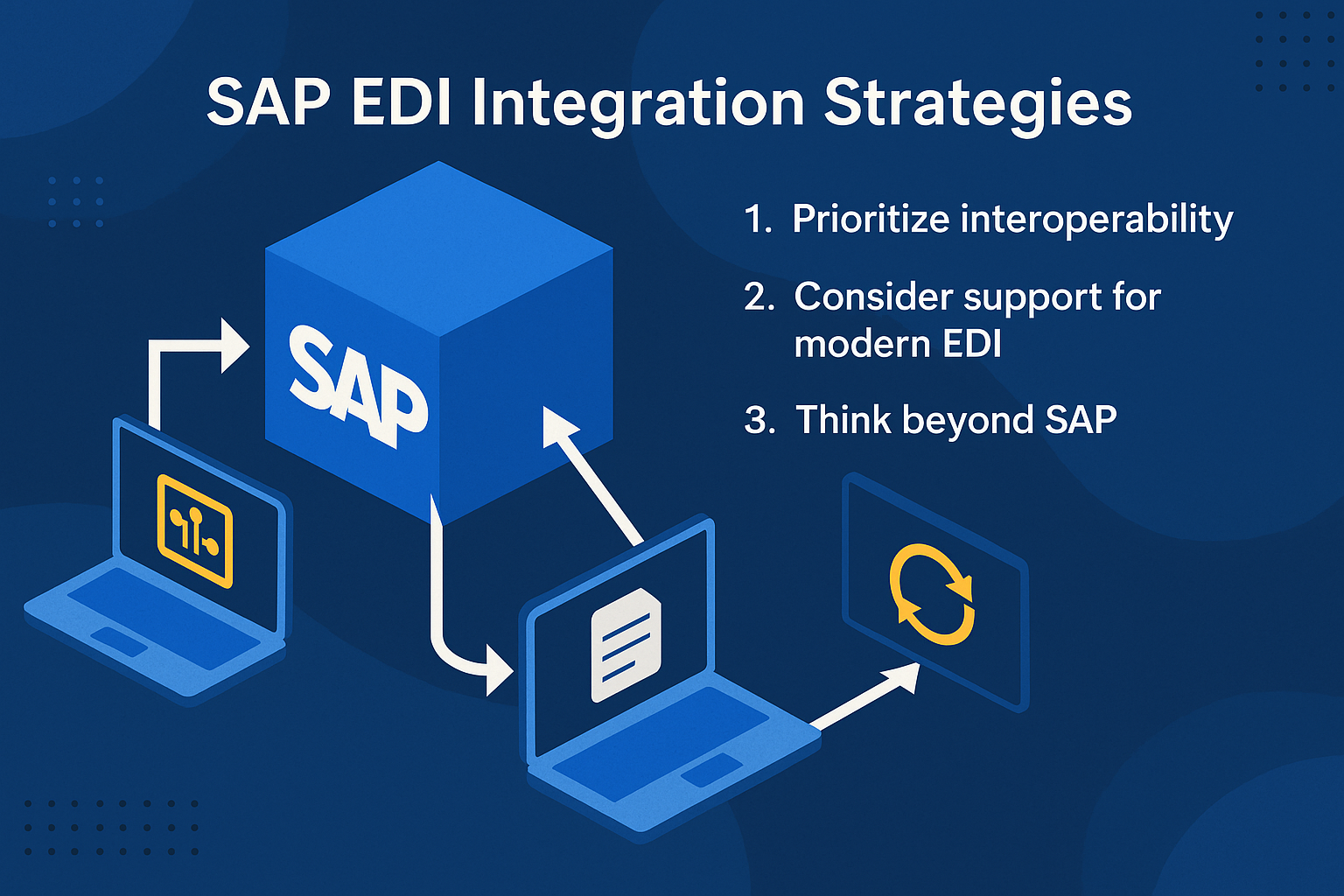Ensure EDI continuity before, during, and after your SAP HANA migration. Learn how to integrate smarter and streamline operations with modern tools.
Migrating to SAP HANA or SAP S/4HANA is a major upgrade, but the stakes are even higher for companies relying on electronic data interchange (EDI). Broken integrations, missed transactions, and delayed trading partner onboarding can turn a routine transition into an operational risk. As IT and operations teams navigate this shift, ensuring the integration is stable and scalable must be part of the plan from day one. Learn how to safeguard the performance of EDI in your SAP HANA migration, and discover why modern integration platforms are key to success.
Why EDI Matters in Your SAP HANA Migration
Electronic data interchange (EDI) sits at the core of many enterprise operations, facilitating the exchange of purchase orders, invoices, shipping notices, and other business documents with trading partners. For organizations migrating to SAP HANA or SAP S/4HANA, preserving these integrations is critical to avoiding costly disruptions.
Having a SAP EDI integration in place helps ensure that data continues to flow smoothly between internal systems and external partners during and after migration. Without a reliable plan, delays in EDI message flow can impact everything from order fulfillment to compliance reporting.
A successful SAP migration should protect and improve EDI capabilities. Modernizing your EDI strategy alongside your SAP ERP upgrade can streamline operations, reduce manual intervention, and improve supply chain visibility.
Mapping Your EDI Landscape Pre-Migration
Before beginning your SAP HANA migration, take inventory of your current EDI environment. This includes identifying all active trading partners, the types of EDI transactions being exchanged, and the protocols supporting them, such as ANSIX12, EDIFACT, AS2, and SFTP.
Many organizations still rely on legacy EDI subsystems or value-added networks (VANs) that require significant manual intervention. If not documented and addressed early, these dependencies can complicate a migration.
You’ll also want to assess your internal systems and their interaction with EDI data, especially if you’re updating or replacing your ERP, WMS, or accounting software. By identifying integration points, communication methods, and transformation logic ahead of time, your team can avoid last-minute surprises and ensure a smoother migration process.
SAP EDI Integration Strategies
Migrating to SAP S/4HANA or SAP Cloud ERP is the ideal time to reevaluate your EDI integration strategy. SAP provides several tools, including SAP Process Orchestration (PO), SAP Process Integration (PI), and the cloud-native SAP Integration Suite, each with different capabilities for supporting EDI workflows.
Legacy approaches like PO and PI typically rely on message brokers and on-premise infrastructure. While functional, they require more hands-on configuration and can become bottlenecks when scaling to support new trading partners, formats, or systems.
Many modern enterprises prefer the SAP Integration Suite. It supports API-based connectivity, offers broad adapter coverage, and integrates more easily with third-party platforms, making it ideal for automating business processes and minimizing manual intervention.
When choosing your strategy, consider these recommendations:
Prioritize interoperability: Choose platforms that easily connect to external trading partners and other business systems (like your WMS or TMS).
Consider support for modern EDI: Look for native support for multiple EDI formats and real-time messaging where possible.
Think beyond SAP: Select an integration platform that aligns with your entire EDI landscape, not just internal SAP workflows.
Whatever path you take, aligning your integration platform with SAP and EDI requirements helps streamline operations and ensure business continuity.

Best Practices to Ensure a Smooth EDI Transition
A successful SAP migration is as much about preserving and improving systems connected to an ERP as it is about upgrading. Connected systems include your EDI infrastructure. These practices will help minimize disruption and maintain operational continuity:
Involve EDI teams early in the migration timeline. Too often, EDI is treated as an afterthought, leading to delays in testing or partner onboarding.
Document all message flows and transformation logic. This includes mapping rules, communication protocols, and error-handling paths for all trading partners.
Use a staging environment for testing. Simulate common EDI transactions, like purchase orders and invoices, with key partners before cutover.
Coordinate with trading partners early. Notify trading partners well in advance and build time into the schedule for troubleshooting connection issues or data mismatches.
Monitor closely post-migration. Track EDI messages in real time to quickly identify failures or data anomalies.
These practices help solve problems while creating opportunities to streamline operations and improve efficiency long after migration is complete.
Post-Migration Optimization Opportunities
Once your SAP HANA migration is complete, the real opportunity to improve how your systems and trading partners exchange information begins. With the right EDI platform, you can build on your migration by addressing long-standing inefficiencies and unlocking greater agility across your operations.
Faster trading partner onboarding is one of the biggest wins. By streamlining connection setups and reducing manual data mapping, your team can add new partners quickly, without bottlenecks or delays in revenue flow.
You can also integrate EDI with other core applications, such as your MRP, CRM, or transportation management system. These integrations improve data accuracy, reduce reconciliation steps, and give stakeholders better visibility into business processes.
A modern EDI setup allows for stronger monitoring, reporting, and exception handling. This lets you catch issues early and respond quickly. Post-migration is the perfect time to revisit what your EDI system can do and what it can do better.
SAP HANA Migration & EDI Impact
Migration Stage | Key EDI Considerations | Common Challenges | How Orderful Helps |
|---|---|---|---|
Pre-Migration | Inventory and partner data audit | Mapping outdated EDI connections to new SAP schema | Automated partner onboarding and validation |
Migration Phase | Testing IDocs, AS2, and APIs with sandbox environments | Downtime or message loss during cutover | Real-time API-based testing and monitoring |
Post-Migration | Ensuring data consistency across systems | Delays in transaction confirmations | Continuous visibility and alerting for every transaction |
Optimization | Leveraging new SAP capabilities with modern EDI | Underutilizing API potential | Unified API-EDI platform for scalable integrations |
Business Benefits of EDI Modernization
While EDI is often viewed as a technical necessity, its benefits extend far beyond data transmission. When integrated properly, particularly during major transitions like a move to SAP S/4HANA or SAP Cloud Platform integration, modern EDI software becomes a strategic asset.
Automation
A powerful EDI solution automates business transactions across multiple SAP systems and external platforms, reducing manual intervention and increasing data accuracy. Streamlining various business processes helps eliminate redundant workflows, lower operating costs, and reduce the risk of compliance errors.
Supply Chain Management
EDI enables real-time exchange of electronic documents, such as advance shipping notices (EDI 856), invoices (EDI 810), and purchase orders (EDI 850), across complex trading networks. With fewer delays and less human input, organizations can react more quickly to supply chain disruptions and maintain better service levels.
Business Agility
Modern systems support SAP Cloud Platform integration and can connect with other critical computer systems, enabling a more agile, integrated approach to managing operations end-to-end.
Compliance
Modern EDI platforms also improve auditability and regulatory compliance. With structured, timestamped message flows and digital recordkeeping, businesses can more easily meet industry requirements such as EDIFACT, HIPAA, and SOX. This reduces the burden on internal compliance teams and lowers the risk of costly reporting errors or failed audits.
Let EDI Drive You Towards Long-Term Success
Migrating to SAP S/4HANA or SAP Cloud ERP allows you to rethink how your organization handles EDI. With the right planning, tools, and integration strategy, you can reduce risk, streamline operations, and set your organization up to meet its long-term business goals.
Modern EDI platforms like Orderful make it easier to manage trading partner relationships, improve data accuracy, and connect with other business-critical systems. If your organization is planning a migration, now is the time to ensure EDI is part of the conversation instead of an afterthought.
Speak to an EDI expert today to learn how Orderful can help you integrate faster, onboard smarter, and stay connected throughout your migration.
SAP S/4HANA FAQs
What is HANA EDI?
HANA EDI refers to running your EDI integrations in an SAP HANA or SAP S4HANA environment while keeping document flows stable. It covers maps, protocols, and partner connections that must continue to work during and after migration.
Why does EDI matter in an SAP ERP migration to HANA?
EDI matters because purchase orders, ASNs, and invoices keep revenue moving. During an SAP ERP migration to HANA, any EDI outage can stall order fulfillment, delay cash flow, and trigger chargebacks.
What are SAP HANA migration services for EDI?
SAP HANA migration services for EEDI are consulting and technical services that inventory your current EDI flows, rebuild or rehost integrations, run parallel testing, and cut over with monitoring so documents continue to post cleanly.
How do companies ensure business continuity during EDI platform upgrades?
Companies ensure continuity by documenting all partner maps, testing in a staging environment, running dual processing during cutover, monitoring 997 and MDN receipts, and having rollback and retry plans for any failed transactions.
What is SAP EDI 850 mapping?
SAP EDI 850 mapping is the translation of an inbound purchase order into SAP fields used by S4HANA or ECC. It aligns segments like BEG, PO1, PID, and CTT to the target IDoc or API so orders create with the right items, quantities, and prices.
How do I validate SAP EDI 850 mapping during migration?
Validate by sending test 850 files from key partners, comparing IDoc or API payloads to expected field values, confirming unit of measure and pricing, and verifying that sales orders post without manual rework.
What is SAP Cloud Platform Integration EDI?
SAP Cloud Platform Integration EDI uses SAP Integration Suite to connect trading partners, transform EDI messages, and deliver them to SAP via APIs or IDocs. It supports AS2, SFTP, and other protocols with central monitoring.
Does SAP support cloud native operations for EDI?
Yes. With SAP Integration Suite you can run cloud native operations for EDI, including autoscaling, versioned mappings, centralized logging, and alerting that fits a modern DevOps model.
What are common EDI transactions to safeguard in a migration?
Common transactions include 850 Purchase Order, 855 Purchase Order Acknowledgment, 856 Advance Ship Notice, 810 Invoice, 846 Inventory Inquiry, 940 Warehouse Order, and 997 Functional Acknowledgment.
How do I handle partner specific EDI requirements during SAP S4HANA migration?
Collect each partner’s implementation guide, lock versions, freeze changes during testing, add map level validations for required qualifiers, and test label and carton data for partners that validate pack level detail.
What protocols should I plan for when moving EDI to HANA?
Plan for AS2, SFTP, and VAN mailboxes. Confirm certificates, IP allowlists, directory paths, and MDN or 997 behavior. Re issue credentials if endpoints change.
What is the best way to phase cutover for EDI?
Best practice is a phased cutover by partner or message type. Start with low risk flows, then move high volume partners once monitoring and retries are proven.
How do I monitor EDI health after go live?
Use dashboards to track message volume, 997 rates, error codes, and processing time. Set alerts for failed envelopes, map exceptions, and posting errors inside SAP.
What is the difference between SAP ERP HANA migration and S4HANA for EDI?
SAP ERP on HANA modernizes the database layer, while S4HANA updates data models and interfaces. EDI impacts are larger with S4HANA due to IDoc and API changes that affect mapping and posting logic.
When should I bring in a provider for HANA EDI?
Bring in a provider if you have tight timelines, many partner maps, multiple protocols, or limited internal expertise with SAP Integration Suite. External teams can accelerate discovery, testing, and cutover.
- 01Why EDI Matters in Your SAP HANA Migration
- 02Mapping Your EDI Landscape Pre-Migration
- 03SAP EDI Integration Strategies
- 04Best Practices to Ensure a Smooth EDI Transition
- 05Post-Migration Optimization Opportunities
- 06SAP HANA Migration & EDI Impact
- 07Business Benefits of EDI Modernization
- 08Let EDI Drive You Towards Long-Term Success
- 09SAP S/4HANA FAQs

